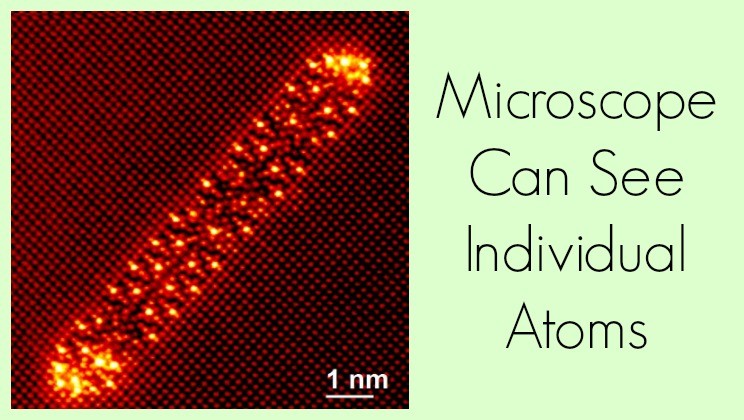Picture that: Microscope can see individual atoms
Posted by staff / March 15, 2015
Who wasn’t fascinated when given the chance to check out what was swimming in their spit looking through a microscope, but just imagine the awe if you could see all the way down to the atomic level?
That’s just what’s happening at the United Kingdom’s SuperSTEM facility with the Nion Hermes Scanning Transmission Electron Microscope, which can zoom in on an object “a million times smaller than a human hair” (though probably not spit, because these are super-professional scientists we’re talking about here, not high school kids).
Why would anyone need to see things that small?
As our technology shrinks, there arises a need to make minute changes to materials at the atomic level. Yet, that’s not all.
Other applications could include nanomedicine— [Quentin] Ramasse [scientist at the SuperSTEM lab] gave the example of needing to check that a drug molecule is sufficiently attached to a nanoparticle acting as a drug delivery vehicle, as “you want to make sure the link is solid so it doesn’t disappear in the body.”
The smallest things can make a huge difference, and now, we can see (or make) it happen.
Full story at Motherboard.
John Dalton would be very eager to see those atoms if he were alive today. After all, he proposed the Atomic Theory of Matter.
Science, Not religion.
Nearly every day now the world of the very small, quantum and Condensed Matter Nuclear doings are making big splashes in physics and manufacturing breakthroughs. I would like to see a picture of what is going on in one of Iraj Parchamazads, Zeolite based LENR devices. Can one of these new Nanoscopes, ooh ooh, new word?, perceive an oscillating electric field? I’d hang the picture on my wall..
Paul Maher
coldfusionnow.org
You wouldn’t have a science if you didn’t have faith… in searching for something that is not known so that it becomes known. Yet, these scientists seem to think the study of nano technology is the way to observe atoms when the common radius of an atom of helium is 31 pico meters… but hey, in that atom there are how many nanometers?
Holy Cow, LOL!
Well, I would call that a nanoscope (or picoscope based on the first comment.)
The depiction of atoms with electrons orbiting nuclei of protons and neutrons is only a human construct. So, it would be nice to directly see atoms and how they really look like. Many believe they look like clouds.
Also, although we take atoms for granted, it is still a mystery how materials are continuous while matter in atoms is less than the space in them.
This existence is wondrous at every level.
Oh, the time stamp is way off, holy cow, LOL!
And, make that “(or picoscope based on the above comment.)”
It looks pretty organized! God must have made it! WOW! God made the world and we understand it through the TOOL of science!
That’s a joke right Mayberry?
Oh, no, another fool who believes a supreme being is at the root of everything. This fantastic piece of technology no more proves the existence of ‘God’ than the optical microscope I was given as a child.
Finally, visible observational proof that Democritus and Epicurus were right about the existence of atoms and void (space). Aristotle (and many others) were wrong believing in the “four elements’ composition of nature, namely earth, wind, fire and water, instead of atoms, as well as in the nonexistence of void (space).
@ELINI: A common mistake…to think that the atoms we know about today are in any way similar to the “Democritus Atom”. Democritus believed that the atom was indestructible, so what he was really talking about was the smallest piece of matter that could no longer be divided in any way. Today we might venture to say that the “Democritus Atom” is closer to quarks and leptons… points, lacking any dimension, clearly indivisible and uncuttable, and devoid of shape.
Democritus would be very eager to see those atoms if he were alive today. After all, he is primarily remembered today for his formulation of an atomic theory of the universe.
Zoom in more and more, you will find all in this 3d realm are pixels and nothing more, all identical pixels of energy merely seeming to express different appearances and functions based on our cognitive and observational perspective. Welcome to my world.
i think if we go deeper, at some point we will see ourselves. I mean your eye looking at you!
@Mayberry M.
Indeed!
Romans 1:20
Colossians 1:16
Hebrews 11:3
Cover of Scientific American, I believe it was July 1957; close to that if not exactly.
The instrument was called, the “field ion microscope,” and it imaged the atoms on the tip of a super-fine-point tungsten needle (about 100 Å = 10 nm diameter).
Of course, the drawback was, you couldn’t just prepare any old sample for this instrument — it had to be a very highly curved surface, of a material that could withstand kilovoltages and cryogenic temperatures in vacuum without degrading. The STEM has a somewhat limited, but still, much more versatile menu of samples.